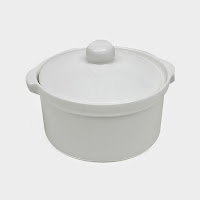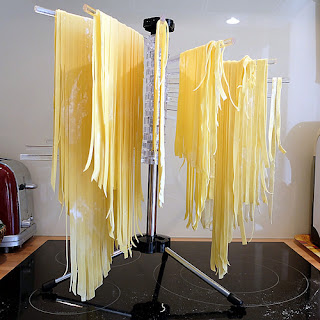from
Behind the French Menu
by
Bryan G. Newman
behindthefrenchmenu@gmail.com
Wheels
of the Salers AOP and Cantal AOP Cheeses.
Also
called the Fourme de Salers AOP and the Fourme de Cantal AOP
Each
wheel weighs between 35 to 45 kilos (77 to 100 lbs).
Cantal AOP and Salers AOP.
The French word fourme, part of the name of many
other French cheeses, comes from the Latin word for the shape. Fourme was also
the old French word for cheese before fromage became accepted; the Italian word
for cheese, Formaggio, has the same Latin origin.
The Cantal and Salers cheeses are both 30% fat,
yellow, semi-hard, cows' milk cheeses, made with milk from the Salers breed of
cattle. Both cheeses are produced in Cantal, one of the four departments in
the Auvergne region that
since 1-1-2016 is part of the super region called
the Auvergne-Rhône-Alpes. Both cheeses claim origins that go back 2,000 years
to when the Romans occupied much of France. The cheeses' true origins may not
go back to the Roman Empire, but certainly, they go back a few hundred years,
and coming from the milk of a single breed of cows indicates that they
developed together.
Cantal AOP
The Cantal cheese has two versions, a farm produced
version called a Cantal Fermier made with unpasteurized milk, and a dairy
produced version called a Cantal Laitier made with pasteurized milk. Cantal
AOP, in both farm and dairy versions, comes in three age groups.
Wheels
of Cantal AOP at their three ages.
Jeune
or Doux – Young and mild. The
youngest cheese and it will have been matured from one to three months; it has
an ivory color and a mild, slightly nutty flavor.
Entre
Deux – Between the two. A cheese
matured for 3 to 6 months, now turning yellow and tasting somewhat like a mild
cheddar.
Vieux – Old.
The Vieux Cantal will have been matured for at least six months. It begins with
a taste somewhat similar to the taste of mature cheddar, and after nine months to
a year or even older, it will be very different with a texture somewhat similar
to Parmesan but with a much stronger
taste.
Cantal
Vieux
www.flickr.com/photos/julienfour/26280943128/
The Salers AOP is one of only two French cheeses that
for their AOP label that not only must come from free grazing in the high
pastures, but the cheese itself must be made there. When the cows that produce
the Salers AOP cheese are brought down from their mountain pastures, their milk
cannot be used for the Salers AOP cheese.
Salers AOP
Taking Cantal AOP and Salers AOP
home.
Buy your Cantal AOP in a Fromagerie, a specialist
cheese shop. If they have regular customers who buy Cantal, they will offer at
least two options. Then, if you look like a serious customer, you may be
offered a sliver of each; if you are lucky, you may be offered a sliver from a
Salers AOP to compare. However, from my experience, Salers AOP is not always
available, and at times you may have to check a number of cheese shops until
you find some.
Taking home a kilo or two of a Cantal AOP or Salers
AOP cheese is a worthwhile expense. Buy a wedge of freshly cut cheese and have
it wrapped and then vacuum wrapped. Semi-hard cheeses travel for two or three
days if kept out of direct heat. When you arrive home, keep the cheese in the
refrigerator, not the freezer, wrapped in plastic wrap. Treat Cantal and Salers
like cheddar or another semi-hard cheese. When you want to eat some of the
cheese, cut off a wedge and wait an hour or so before eating. The rest wrap in
plastic wrap and return to its closed box in the refrigerator. Cantal and
Salers will keep well for one or two months, or at least until you have finished
eating it. For the link to Buying Cheese in France and taking it home, click
here.
Taking a whole Cantal AOP and Salers AOP cheese home
will not be easy; both cheeses come in wheels that weigh between 35 to 45 kilos
(77 to 100 lbs). There are smaller wheels of the Cantal AOP cheese, but will
still create problems as EasyJet carry-ons. The smallest Cantal AOP wheel,
called a Cantalet, weighs about 8- 10 kil0s (18 to 22 pounds), and the medium
size, called the Petit Cantal, weighs between 16-20 kilos (34 to 24 lbs).
The names Cantal and Salers
The name Cantal is the name of a department in the
Auvergne comes from the Monts du Cantal, the Cantal mountains, These mountains
are set around an enormous extinct volcano in the center of the department. The
village of Salers is at an altitude of 950 meters in the center of Cantal; it
was once a medieval city and now is one of the most beautiful villages in all
of France.
The cheese's other names, the Fourme de Salers AOP
and the Fourme de Cantal AOP, are part of cheese history. French word fourme,
which is part of the name of many other French cheeses, comes from the Latin
word for the word shape. Fourme was also the old French word for cheese before
fromage became accepted, and the Italian word for cheese, Formaggio, has the
same Latin origin.
Visiting
Cantal by train may take you over the Garabit Viaduct.
The viaduct spans the River Truyère, near
Ruynes-en-Margeride in the department of Cantal; it was built by.
www.flickr.com/photos/inra_dist/39045791381/
Cantal AOP and Salers AOP on French menus.
The Salers AOP is rarely seen on menus and then
usually at the centerpiece of a cheese plate. In Auvergne restaurants,
your menu may offer:
Clafoutis
Moelleux aux Cantal AOP –
A soft clafoutis made with a crepe-like
batter and Cantal AOP cheese. Whether a clafoutis should be considered a tart,
flan or pie is much disputed.
Filet de Veau Cuit
en Base Température, Jus de
Moutarde,
Croquette de Pomme de Terre au Cantal - A fillet veal of
cooked slowly at a low temperature, served with a gravy made from the natural cooking juices and mustard, accompanied by potato croquettes
made with Cantal cheese.
La Truffade du Cantal – The truffade of Cantal is a
traditional dish from the Auvergne. The truffade du Cantal is made of sliced
potatoes cooked with Cantal cheese, flavored with bacon and garlic; all are cooked together and
served like a cake. Occasionally this dish may be on the menu with Salers AOP.
A view of the village of Salers.
www.flickr.com/photos/pom-angers/32305918088/
Aligot
d'Auvergne Saucisse et Salade de Printemps – Auvergne Aligot served with an Auvergne sausage
and a spring salad. Aligot is one of the Auvergne's most popular dishes. The Auvergne
Aligot is a young Cantal AOP or Tomme cheese blended with mashed potatoes
garlic, crème fraîche, and milk and butter and olive oil. From
personal experience on a cold winter's evening, after forty minutes in the
freezing cold, while looking for a taxi and no time for lunch, the smell alone
can be mistaken for the ambrosia of the gods. (The traditional Auvergne sausage
is a small salami type sausage, about 100 grams, made with pork, pork fat, and
beef; when served with Aligot, it is usually grilled. When this sausage is not
served with Aligot, it may then be eaten uncooked like any salami type sausage). The spring salad
accompanying the Aligot and sausage on the menu will include uncooked young
vegetables, sprouts, and young vegetable shoots.
Traveling in Cantal and the
Auvergne
Nearly all Frenchmen and women will have tried Cantal
AOP and or the Salers AOP cheeses; however, few will have visited the beautiful
department of Cantal. Cantal has a population of fewer than 150,000; that's
just about 26 people per square km.
To find Cantal on a map of France, take a pin and
point it at France's geographic center; that is the old region of Auvergne with
the department of Cantal in the Auvergne's South-West; since 1-1-2016 is part
of the new super-region of the Auvergne-Rhône-Alpes. Apart from these two AOP
cheeses, Cantal has a third the Bleu d'Auvergne AOP apart from many other excellent local
cheeses.
The
Auvergne on the map of France.
Cantal
is department number 15.
Apart from a very large extinct volcanic massif in
the center of the department of Cantal everywhere, there are green pastures,
clean running rivers, and beautiful lakes. Those green pastures serve as
grazing pastures for the Salers cows that produce the milk for the Cantal and
Salers cheeses, but they become skiing centers in the winter. Those skiing
areas reach high to the massif reaching over 1,800 meters. Cantal, like much of
the region of the Auvergne-Rhône-Alpes, is one of the most unspoiled parts of France.
Skiing
in Cantal in winter.
www.flickr.com/photos/mikelo/3141958582/
If you are visiting the Auvergne, consider taking
their Route de Fromage, their cheese road; it includes the five AOP cheeses of
the region. However, if you are near the town of Ambert, the home of the Bleu
d'Auvergne in the department of Puy-de-Dôme, then stop by and visit the town's
Maison de la Fourme d'Ambert et de Fromages d'Auvergne. There, for a small contribution to the local
economy, you may taste all five of the Auvergne's
AOP cheeses.
Cantal
AOP
Salers
AOP
While in the department of Cantal or
anywhere else in Auvergne for that matter, try their Coq au Vin de Chanturgue –
The original Coq au Vin, most chefs
agree, that it was prepared with the Chanturgue AOC/AOP red wine of the Auvergne. For
more about the original Coq au Vin, see the post: Coq au Vin, the Traditional Version
is Much More Than Just a Chicken Stewed in Wine.
--------------------------------
Behind the French Menu
by
Bryan G. Newman
behindthefrenchmenu@gmail.com
Copyright 2010, 2014, 2019
--------------------------------
Searching for the meaning of words, names or phrases
on
French menus?
Just add
the word, words, or phrase that you are searching for to the words "Behind
the French Menu" (best when including the inverted commas), and search with
Google, Bing, or another browser. Behind the French Menu’s links,
include hundreds of words, names, and phrases that are seen on French menus.
There are over 450 articles that include over 4,000 French dishes with English
translations and explanations.
Connected posts:



















